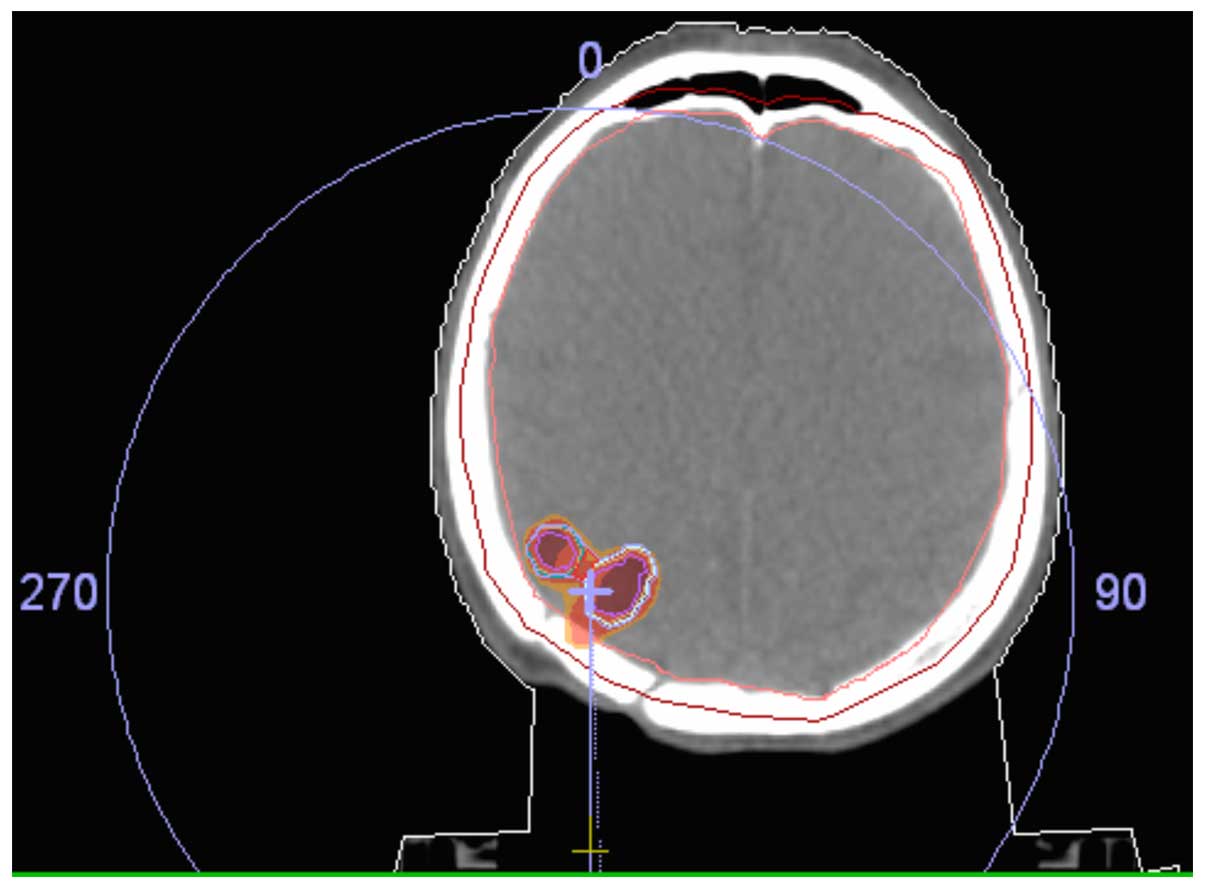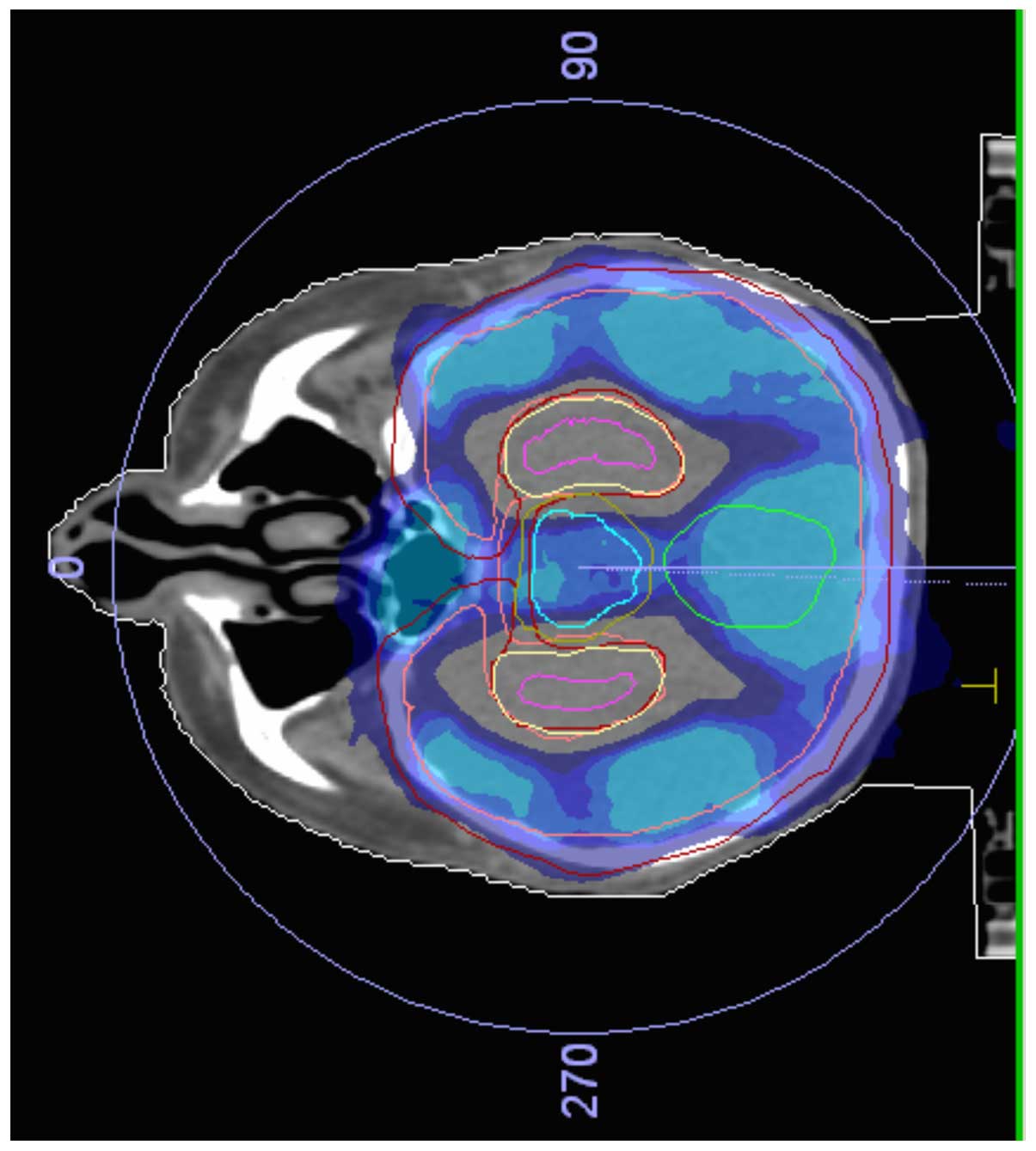|
1
|
Culine S, Bekradda M, Kramar A, Rey A,
Escudier B and Droz JP: Prognostic factors for survival in patients
with brain metastases from renal cell carcinoma. Cancer.
83:2548–2553. 1998. View Article : Google Scholar : PubMed/NCBI
|
|
2
|
Escudier B, Porta C, Schmidinger M, Algaba
F, Patard JJ, Khoo V, Eisen T and Horwich A: ESMO Guidelines
Working Group: Renal cell carcinoma: ESMO Clinical Practice
Guidelines for diagnosis, treatment and follow-up. Ann Oncol.
25(Suppl 3): iii49–iii56. 2014. View Article : Google Scholar : PubMed/NCBI
|
|
3
|
Tsao MN, Rades D, Wirth A, Lo SS,
Danielson BL, Gaspar LE, Sperduto PW, Vogelbaum MA, Radawski JD,
Wang JZ, et al: Radiotherapeutic and surgical management for newly
diagnosed brain metastasis(es): An American Society for Radiation
Oncology evidence-based guideline. Pract Radiat Oncol. 2:210–225.
2012. View Article : Google Scholar : PubMed/NCBI
|
|
4
|
Minniti G, D'Angelillo RM, Scaringi C,
Trodella LE, Clarke E, Matteucci P, Osti MF, Ramella S, Enrici RM
and Trodella L: Fractionated stereotactic radiosurgery for patients
with brain metastases. J Neurooncol. 117:295–301. 2014. View Article : Google Scholar : PubMed/NCBI
|
|
5
|
Kim YJ, Cho KH, Kim JY, Lim YK, Min HS and
Lee SH, Kim HJ, Gwak HS, Yoo H and Lee SH: Single-dose versus
fractionated stereotactic radiotherapy for brain metastases. Int J
Radiat Oncol Biol Phys. 81:483–489. 2011. View Article : Google Scholar : PubMed/NCBI
|
|
6
|
Gaspar L, Scott C, Rotman M, Asbell S,
Phillips T, Wasserman T, McKenna WG and Byhardt R: Recursive
partitioning analysis (RPA) of prognostic factors in three
Radiation Therapy Oncology Group (RTOG) brain metastases trials.
Int J Radiat Oncol Biol Phys. 37:745–751. 1997. View Article : Google Scholar : PubMed/NCBI
|
|
7
|
Nieder C, Marienhagen K, Geinitz H and
Molls M: Validation of the graded prognostic assessment index for
patients with brain metastases. Acta Oncol. 48:457–459. 2009.
View Article : Google Scholar : PubMed/NCBI
|
|
8
|
Villà S, Weber DC, Moretones C, Mañes A,
Combescure C, Jové J, Puyalto P, Cuadras P, Bruna J, Verger E, et
al: Validation of the new graded prognostic assessment scale for
brain metastases: A multicenter prospective study. Radiat Oncol.
6:232011. View Article : Google Scholar : PubMed/NCBI
|
|
9
|
Nieder C, Andratschke NH, Geinitz H and
Grosu AL: Diagnosis-specific graded prognostic assessment score is
valid in patients with brain metastases treated in routine clinical
practice in two European countries. Med Sci Monit. 18:CR450–CR455.
2012. View Article : Google Scholar : PubMed/NCBI
|
|
10
|
International Commission on Radiation
Units and Measurements: Prescribing, Recording and Reporting Photon
Beam Therapy (Report 50). Bethesda: 1993.
|
|
11
|
International Commission on Radiation
Units and Measurements: Prescribing, Recording and Reporting Photon
Beam Therapy (Report 62). Bethesda: 1999.
|
|
12
|
International Commission on Radiation
Units and Measurements: Prescribing, Recording and Reporting
Intensity-Modulated Photon-Beam Therapy (IMRT) (ICRU Report 83).
Washington: 2010.
|
|
13
|
Gondi V, Pugh SL, Tome WA, Caine C, Corn
B, Kanner A, Rowley H, Kundapur V, DeNittis A, Greenspoon JN, et
al: Preservation of memory with conformal avoidance of the
hippocampal neural stem-cell compartment during whole-brain
radiotherapy for brain metastases (RTOG 0933): A phase II
multi-institutional trial. J Clin Oncol. 32:3810–3816. 2014.
View Article : Google Scholar : PubMed/NCBI
|
|
14
|
Rades D, Bohlen G, Pluemer A, Veninga T,
Hanssens P, Dunst J and Schild SE: Stereotactic radiosurgery alone
versus resection plus whole-brain radiotherapy for 1 or 2 brain
metastases in recursive partitioning analysis class 1 and 2
patients. Cancer. 109:2515–2521. 2007. View Article : Google Scholar : PubMed/NCBI
|
|
15
|
Karlovits BJ, Quigley MR, Karlovits SM,
Miller L, Johnson M, Gayou O and Fuhrer R: Stereotactic
radiosurgery boost to the resection bed for oligometastatic brain
disease: Challenging the tradition of adjuvant whole-brain
radiotherapy. Neurosurg Focus. 27:E72009. View Article : Google Scholar : PubMed/NCBI
|
|
16
|
Kocher M, Soffietti R, Abacioglu U, Villà
S, Fauchon F, Baumert BG, Fariselli L, Tzuk-Shina T, Kortmann RD,
Carrie C, et al: Adjuvant whole-brain radiotherapy versus
observation after radiosurgery or surgical resection of one to
three cerebral metastases: Results of the EORTC 22952–26001 study.
J Clin Oncol. 29:134–141. 2011. View Article : Google Scholar : PubMed/NCBI
|
|
17
|
Iwadate Y, Namba H and Yamaura A:
Whole-brain radiation therapy is not beneficial as an adjuvant
therapy for brain metastases compared with localized irradiation.
Anticancer Res. 22:325–330. 2002.PubMed/NCBI
|
|
18
|
Mintz A, Perry J, Spithoff K, Chambers A
and Laperriere N: Management of single brain metastasis: A practice
guideline. Curr Oncol. 14:131–143. 2007. View Article : Google Scholar : PubMed/NCBI
|
|
19
|
Aoyama H, Shirato H, Tago M, Nakagawa K,
Toyoda T, Hatano K, Kenjyo M, Oya N, Hirota S, Shioura H, et al:
Stereotactic radiosurgery plus whole-brain radiation therapy vs
stereotactic radiosurgery alone for treatment of brain metastases:
A randomized controlled trial. JAMA. 295:2483–2491. 2006.
View Article : Google Scholar : PubMed/NCBI
|
|
20
|
Tsao MN, Lloyd NS and Wong RK: Supportive
Care Guidelines Group of Cancer Care Ontario's Program in
Evidence-based Care: Clinical practice guideline on the optimal
radiotherapeutic management of brain metastases. BMC Cancer.
5:342005. View Article : Google Scholar : PubMed/NCBI
|
|
21
|
Khuntia D, Brown P, Li J and Mehta MP:
Whole-brain radiotherapy in the management of brain metastasis. J
Clin Oncol. 24:1295–1304. 2006. View Article : Google Scholar : PubMed/NCBI
|
|
22
|
Soon YY, Tham IW, Lim KH, Koh WY and Lu
JJ: Surgery or radiosurgery plus whole brain radiotherapy versus
surgery or radiosurgery alone for brain metastases. Cochrane
Database Syst Rev. 3:CD0094542014.PubMed/NCBI
|
|
23
|
Kocher M, Maarouf M, Bendel M, Voges J,
Müller RP and Sturm V: Linac radiosurgery versus whole brain
radiotherapy for brain metastases. A survival comparison based on
the RTOG recursive partitioning analysis. Strahlenther Onkol.
180:263–267. 2004. View Article : Google Scholar : PubMed/NCBI
|
|
24
|
Rades D and Schild SE: Do patients with a
limited number of brain metastases need whole-brain radiotherapy in
addition to radiosurgery? Strahlenther Onkol. 188:702–706. 2012.
View Article : Google Scholar : PubMed/NCBI
|
|
25
|
Golden DW, Lamborn KR, McDermott MW,
Kunwar S, Wara WM, Nakamura JL and Sneed PK: Prognostic factors and
grading systems for overall survival in patients treated with
radiosurgery for brain metastases: Variation by primary site. J
Neurosurg. 109(Suppl): S77–S86. 2008.
|
|
26
|
Kocher M, Wittig A, Piroth MD, Treuer H,
Seegenschmiedt H, Ruge M, Grosu AL and Guckenberger M: Stereotactic
radiosurgery for treatment of brain metastases. A report of the
DEGRO working group on stereotactic radiotherapy. Strahlenther
Onkol. 190:521–532. 2014. View Article : Google Scholar : PubMed/NCBI
|
|
27
|
Bates JE, Youn P, Peterson CR III, Usuki
KY, Walter KA, Okunieff P and Milano MT: Radiotherapy for brain
metastases from renal cell carcinoma in the targeted therapy Era:
The university of Rochester experience. Am J Clin Oncol. 2015 Feb
26;(Epub ahead of print). View Article : Google Scholar : PubMed/NCBI
|
|
28
|
Fokas E, Henzel M, Hamm K, Surber G,
Kleinert G and Engenhart-Cabillic R: Radiotherapy for brain
metastases from renal cell cancer: Should whole-brain radiotherapy
be added to stereotactic radiosurgery? Analysis of 88 patients.
Strahlenther Onkol. 186:210–217. 2010. View Article : Google Scholar : PubMed/NCBI
|
|
29
|
Rades D, Kueter JD, Hornung D, Veninga T,
Hanssens P, Schild SE and Dunst J: Comparison of stereotactic
radiosurgery (SRS) alone and whole brain radiotherapy (WBRT) plus a
stereotactic boost (WBRT+SRS) for one to three brain metastases.
Strahlenther Onkol. 184:655–662. 2008. View Article : Google Scholar : PubMed/NCBI
|
|
30
|
Chang EL, Wefel JS, Hess KR, Allen PK,
Lang FF, Kornguth DG, Arbuckle RB, Swint JM, Shiu AS, Maor MH and
Meyers CA: Neurocognition in patients with brain metastases treated
with radiosurgery or radiosurgery plus whole-brain irradiation: A
randomised controlled trial. Lancet Oncol. 10:1037–1044. 2009.
View Article : Google Scholar : PubMed/NCBI
|
|
31
|
Mizumatsu S, Monje ML, Morhardt DR, Rola
R, Palmer TD and Fike JR: Extreme sensitivity of adult neurogenesis
to low doses of X-irradiation. Cancer Res. 63:4021–4027.
2003.PubMed/NCBI
|
|
32
|
Collier TJ, Quirk GJ and Routtenberg A:
Separable roles of hippocampal granule cells in forgetting and
pyramidal cells in remembering spatial information. Brain Res.
409:316–328. 1987. View Article : Google Scholar : PubMed/NCBI
|
|
33
|
Raber J, Rola R, LeFevour A, Morhardt D,
Curley J, Mizumatsu S, VandenBerg SR and Fike JR: Radiation-induced
cognitive impairments are associated with changes in indicators of
hippocampal neurogenesis. Radiat Res. 162:39–47. 2004. View Article : Google Scholar : PubMed/NCBI
|
|
34
|
Rades D, Kueter JD, Pluemer A, Veninga T
and Schild SE: A matched-pair analysis comparing whole-brain
radiotherapy plus stereotactic radiosurgery versus surgery plus
whole-brain radiotherapy and a boost to the metastatic site for one
or two brain metastases. Int J Radiat Oncol Biol Phys.
73:1077–1081. 2009. View Article : Google Scholar : PubMed/NCBI
|
|
35
|
Suh JH: Hippocampal-avoidance whole-brain
radiation therapy: A new standard for patients with brain
metastases? J Clin Oncol. 32:3789–3791. 2014. View Article : Google Scholar : PubMed/NCBI
|
|
36
|
Sahgal A, Larson D and Knisely J:
Stereotactic radiosurgery alone for brain metastases. Lancet Oncol.
16:249–250. 2015. View Article : Google Scholar : PubMed/NCBI
|
|
37
|
Langley RE, Stephens RJ, Nankivell M, Pugh
C, Moore B, Navani N, Wilson P, Faivre-Finn C, Barton R, Parmar MK
and Mulvenna PM: QUARTZ Investigators: Interim data from the
Medical Research Council QUARTZ Trial: does whole brain
radiotherapy affect the survival and quality of life of patients
with brain metastases from non-small cell lung cancer? Clin Oncol
(R Coll Radiol). 25:e23–e30. 2013. View Article : Google Scholar : PubMed/NCBI
|
|
38
|
Prokic V, Wiedenmann N, Fels F, Schmucker
M, Nieder C and Grosu AL: Whole brain irradiation with hippocampal
sparing and dose escalation on multiple brain metastases: A
planning study on treatment concepts. Int J Radiat Oncol Biol Phys.
85:264–270. 2013. View Article : Google Scholar : PubMed/NCBI
|
|
39
|
Ghia A, Tomé WA, Thomas S, Cannon G,
Khuntia D, Kuo JS and Mehta MP: Distribution of brain metastases in
relation to the hippocampus: Implications for neurocognitive
functional preservation. Int J Radiat Oncol Biol Phys. 68:971–977.
2007. View Article : Google Scholar : PubMed/NCBI
|
|
40
|
Antonadou D, Coliarakis N, Paraskevaidis
M, Athanasiou H, Sarris G, Synodinou M, Skarlatos I, Sagriotis A,
Georgakopoulos G, Beroukas C, et al: Whole brain radiotherapy alone
or in combination with temazolamide for brain metastases. A phase
III study. Int J Radiat Oncol Biol Phys. 54:932002. View Article : Google Scholar
|
















